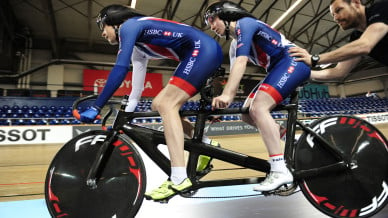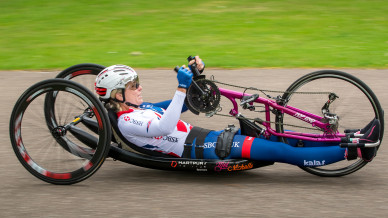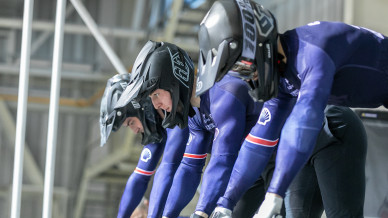About Para Cycling
Introduction to Para Cycling
Whether it's on the track or the road, two wheels or three, para cycling offers something for everyone who wants to get on a bike.
Para cycling was first developed by cyclists with visual impairments who competed on tandem bicycles. Since then the sport has continued to grow and was first introduced to a Paralympic Games in New York in 1984 with road events for athletes with cerebral palsy included for the first time. Further events were added over the course of the next four Paralympic Games, with track cycling making its debut in Atlanta 1996.
Fast forward to Tokyo 2020 Paralympic Games and GBCT collected a total of 24 medals in para cycling events. At the 2022 Commonwealth Games, British visually impaired para cyclists brought home 7 medals.
Classification
Para cycling currently includes individuals with cerebral palsy, visual impairments and physical impairments. Road cyclists compete on handcycles, trikes, tandem bikes or bikes depending on their condition. On the track, cyclists compete on either tandem bikes or bikes.
- C1-C5 is for athletes with cerebral palsy, amputees and other conditions who can ride a bike.
- T1-T2 (trike) is for athletes with cerebral palsy, neurological conditions or other athletes who are unable to ride a bike.
- B is for visually impaired cyclists who compete on tandem bikes with a pilot.
- H1-H5 (handcycle) is for riders with impairments affecting either both legs or a combination of the upper and lower limbs (amputees, paraplegics and tetraplegics)


Para Performance Pathway
To be eligible to compete in para cycling a rider must have an eligible impairment and meet the minimum impairment criteria as set out by the World Para Cycling Classification Rules and Regulations.
Currently athletes with physical impairments and visual impairments are eligible for the para cycling pathway.
Para Cycling events
The bikes
Bike
Many para-cycling riders would ride a typical bike when competing. However depending on the rider’s impairment the bike may be adapted to assist them.

Tandem
A tandem bike is for a rider with a visual impairment. The pilot (sighted rider) will always be on the front, with the stoker (visually impaired rider) on the back.

Tricycle
Trikes are for riders with cerebral palsy, neurological conditions or other riders who are unable to ride a bicycle.

Handcycle
Handbikes are for riders with impairments affecting either both legs or a combination of the upper and lower limbs and will compete in races on the road

Kit and clothing
Clothing
Members of the Great Britain Cycling Team will typically compete in a skinsuit, but don't worry if you don't have one available. T-shirts are fine until they get wet from rain or your sweat, so you may prefer to wear jerseys that will help to draw moisture away from your clothing. You may also be more comfortable on a saddle if you wear padded cycling shorts. For outdoor rides in winter, a lightweight rain jacket can keep you warm and dry.

Helmet
Built for comfort and protection, the many holes in the helmet are vents to keep your head cool. Helmets come in sizes to fit all head shapes and sizes and are adjustable.

Time trial helmet
In a time-trial, which is a race against the clock, the rider will look for every advantage they can get to save them valuable seconds and will wear a specially designed aerodynamic helmet.

Get involved with para cycling
Great Britain Cycling Team opens pathway applications to cycling's future stars
British Cycling has today started its latest search for future talent, as applications for the Great Britian Cycling Team Olympic Development Squads and Podium Potential Squads are now open.

National Series round-up - 26-27 April
Rounding up all the National Series action on the weekend of 26-27 April 2025.

Routes revealed for the 2025 Lloyds National Road Championships

Record field as teams announced for Lloyds Tour of Britain Women












